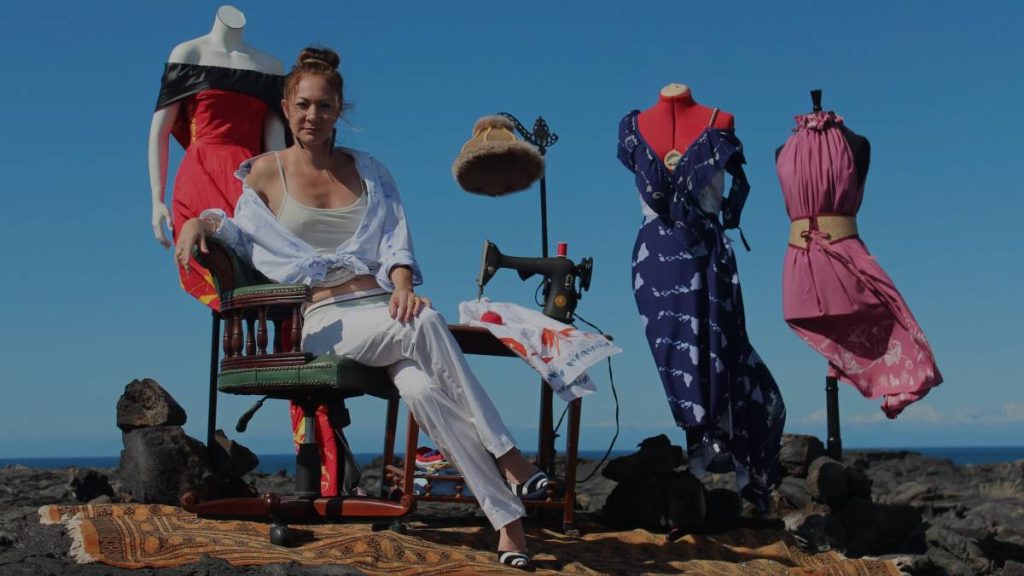Beloved dress is celebrated in style throughout Hawaiʻi during Muʻumuʻu Month

A timeless island fashion is celebrated in style across Hawai‘i in January during Muʻumuʻu Month.
The loose dresses are beloved for their often-vivid colors, lively patterns and wide variety of styles. While less ubiquitous than in decades past, mu‘umu‘u remain a vibrant component of local culture. Women throughout Hawai‘i are working to ensure the tradition carries on to the next generation.
“There are so many gifts that the mu‘u can offer you,” said Shannon Hiramoto, founder of the handmade clothing company machinemachine.

Hiramoto started Mu‘umu‘u Month on Kaua‘i in January 2015, when she invited anyone who entered her shop to select a free mu‘umu‘u, but with strings attached.
“I said, ‘Take it, take them, but you have to wear it,'” Hiramoto recalled. “People loved it.”
Since then, Mu‘umu‘u Month has expanded across the Garden Isle and beyond. Now, every January, the Kaua‘i Historical Society hosts a series of free events culminating in the annual Muʻumuʻu Pāʻina Luncheon fundraiser. The society in years past also has supported celebrations elsewhere in the state.

Mu‘umu‘u originated 200 years ago as white cotton undergarments worn beneath holokū, loose-fitting gowns introduced by Christian missionaries in the 1820s. In subsequent decades, mu‘umu‘u evolved in many ways, as new cultures contributed their own fabrics, designs and patterns.
Hiramoto operates The Mu‘umu‘u Archive, a crowdsourced database of photographs and narratives collected from around the globe. More recently, she researched and edited Wikipedia’s mu‘umu‘u page to reflect a Hawaiian perspective.
Case in point: Hiramoto said Wikipedia’s featured image once had cartoon character Homer Simpson, having gained 76 pounds, dressed in a mu‘umu‘u. In the TV episode, it was explained it was one of the only outfits that could fit his girth.

Now, the featured image is more appropriate, a photograph of a Hawaiian woman playing ʻukulele.
When Hiramoto speaks, the mu‘umu‘u becomes a catalyst for meaningful connections.
“It’s one of those simple things that a 20-year-old can talk to an 80-year-old about,” she said.
The mu‘umu‘u bridges more than generations. The fashion has long been loved by Hawaiian, Japanese and white locals, in addition to women on vacation in Hawai‘i.
“It’s a total democratic garment that everyone can get behind,” Hiramoto said.
Natalie Fonda is the owner and operator of Fonda’s Daughter, a vintage shop in Hanapēpē on the West Side of Kaua‘i. She maintains a fully-stocked rack of mu‘umu‘u at all times, and admits her own closet is also packed with pieces representing every color of the spectrum. She looks forward to wearing a different dress for each day of Mu‘umu‘u Month.

Fonda’s inventory can vary wildly in age and style. Some necklines are low, while others rise above the throat. In the 1930s and ’40s, many mu‘umu‘u were made of silk and exhibited Chinese and Japanese influences like batwing sleeves. Psychedelic colors reigned supreme in the 1960s and ’70s, while subsequent decades introduced ruffles and puffy sleeves. The work of designers like Alfred Shaheen, Tori Richard and Allen Akina is especially prized.
Vintage mu‘umu‘u are relatively scarce on Kaua‘i, according to Fonda. Both she and Hiramoto have been told Hurricane Iniki, which devastated the island in 1992, likely destroyed many.
Luckily, Fonda sometimes finds vintage mu‘umu‘u during buying trips to the mainland. There, the old garments tend to be in excellent condition due to lack of wear.
“Visitors would come to Hawai‘i, buy one, wear it once or twice, and then fly home with it and never wear it again,” Fonda explained. “There’s something really gratifying, knowing a mu‘u is returning to Hawai‘i from the mainland.”
Tourists today show little interest in mu‘umu‘u on sale at Fonda’s Daughter, preferring to buy vintage aloha shirts to wear at a lūʻau. Yet kamaʻāina (native-born or longtime residents of Hawai‘i) beam when they discover Fonda’s dress collection. Some mu‘umu‘u remind locals of a beloved tūtū (grandma) while others conjure happy memories of growing up.
“What’s most important is that they’re loved and appreciated,” said Fonda, who was raised by a self-described treasure hunter. “I’m happy they can be celebrated, appreciated and passed down for many years to come.”
A few hundred miles away, at the opposite end of the main Hawaiian island chain, a professional artist is designing and sewing mu‘umu‘u for wholesale distribution among local retailers.
Trained oil painter Kira Kamamalu, who lives and works in Kaʻū on Hawai‘i Island, developed an interest in other mediums. She was designing fashion lines when the coronavirus pandemic hit in 2020, severing her connections to Asian manufacturers.

An undefeated Kamamalu began to sew and silk-screen mu‘umu‘u from her own home. She now offers four distinct styles, including a strapless dress and a “cold shoulder” version with a ruffle top. Several years ago, she designed a pattern exclusive to the Kaua‘i Museum that honored Kaumualiʻi, the last independent ruler of the island.
“We’re always trying to make a mu‘u that respects and honors grandma, but that a 30-year-old would still wear,” she said.
House of Kamamalu is now a successful business, and Kamamalu said she wants to develop a model that will contribute new economic opportunities to her home and other Hawaiian islands. She’d like to employ several seamstresses in her rural community, where many residents must commute to Kona or Hilo for work.
Indeed, the state of Hawai‘i once boasted a thriving garment industry. Names like Alfred Shaheen, a pioneering designer and manufacturer active in the years following World War II, are still well-known today.
“It’s been done before,” Kamamalu said. “We could do it again. We’ve just got to figure out how.”
For a complete list of free Mu‘umu‘u Month events on Kaua‘i and to purchase tickets to the third annual Muʻumuʻu Pāʻina Luncheon on Jan. 19, visit kauaihistoricalsociety.org.
To visit The Mu‘umu‘u Archive, visit machinemachineapparel.com or themuumuuarchive.com.
Sponsored Content
Comments








